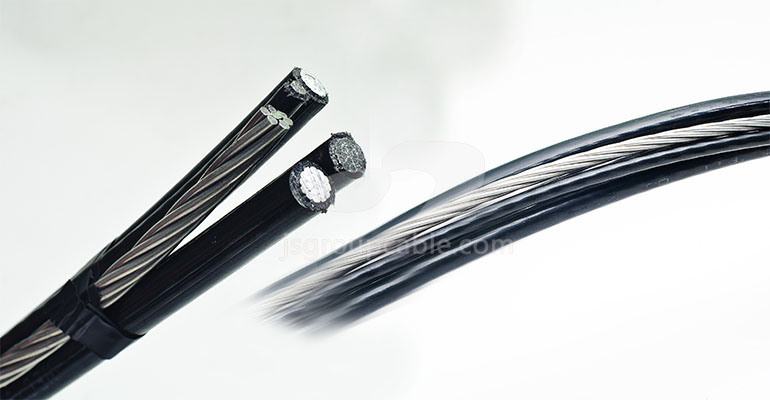- Offices Time:24 Hours Online
- Email:[email protected]
- WhatsApp:+8618339938759

Posted on November 18, 2022
What are the common specifications of overhead bundled cables?
Aerial Bundled Cable is an overhead power line that uses multiple insulated phase conductors tightly bundled together, usually with an exposed neutral conductor. This is in stark contrast to the traditional practice of uninsulated conductors. This variation of overhead power lines utilizes the same principle as bundled conductors, except they are closer to the point of contact, but each conductor is surrounded by insulation.
Using Aerial Bundled Cable can greatly reduce various short circuit faults. Aerial Bundled Cable has approximately 4-6 times lower failure rate compared to overhead bare conductors.
1.The specifications of overhead cables are as follows:
(1) Use ACSR conductor XLPE insulated overhead cable, model JKLGYJ-1, 1X10/2, pole span can be 20 meters, JKLGYJ-11X10/2 long-term allowable carrying capacity is 75A, Consider distance loss, but enough. Pay attention to see whether the local power supply voltage is high or not. If it is relatively low, consider using JKLGYJ-1, 1X16/3, mainly considering the larger line loss of the aluminum core wire.
(2) Do not use wires to pass through the pipe, which is not conducive to heat dissipation. Directly use VLV, 3X10+1X6 or VLV, 0.6/1kV, 3X16+1X10 type aluminum core PVC insulated and sheathed power cables, pull the steel wire ropes on the poles, and use cable hooks or insulated wires to bind the wire ropes. . The reference ampacity of VLV, 3X10+1X6 is 40A, and the reference ampacity of VLV, 0.6/1kV, 3X16+1X10 is 54A. The prices of the two aluminum core cables are not too expensive, basically the same.
Overhead cables refer to the high-voltage transmission lines that the catenary is erected in a zigzag shape along the rails in the electrified railway for pantographs to take current. The catenary is a very important structure of the railway electrification project, and it is a transmission line erected along the railway line to supply power to the locomotive. It is composed of contact suspension, supporting device, positioning device, pillar and foundation.
2.Requirements for overhead lines
(1) Steel-cored aluminum stranded wire or aluminum stranded wire should be used as much as possible for overhead lines. The cross-section of the aluminum stranded wire of the high-voltage overhead line must be greater than 50 square millimeters, and the cross-section of the core aluminum stranded wire must be greater than 35 square millimeters.
(2) The cross-section of the wire should meet the needs of the maximum electric load.
(3) The selection of the section should also meet the requirement that the voltage loss is less than 5% or 2%~3% of the rated voltage, and should meet certain mechanical strength.

3.Advantages of overhead cables
(1) Aerial Bundled Cable can omit one of these connectors. Reduces the risk of neutral only breaking due to tree or vehicle damage. Higher reliability than bare conductor overhead and underground systems.
(2) Power supply security is good. The use of overhead cables greatly reduces the risk of personal electric shock. When the overhead cable is energized, when a human body or animal accidentally touches the insulating surface of the cable, as long as the cable is not broken down, it will not cause harm to humans or animals.
(3) Easy installation and maintenance. Aerial cables can be run on any type of pole and tower or along walls. In special cases, it can also be directly fixed on the tree pole with hardware through the tree.
(4) The economy is reasonable. Although using overhead cables is more expensive than using overhead bare conductors, it is less expensive than ordinary underground installation cables. Therefore, its comprehensive cost is obviously lower, more economical and more reasonable.
(5) Relatively immune to short circuits caused by external forces unless they wear down the insulation. Can stand near trees or buildings, and will not produce sparks if touched. Little to no tree trimming is required and installation is simpler as no crossbars and insulators are required.
4.Aerial cable failure
The most traditional designs are opposed by most because the multiple conductors are considered unattractive and external forces can cause them to touch and short out. It may be the surrounding environment that causes the fire in a dry climate.
Tree growth can be a significant problem for overhead power lines in humid climates. Cables bundled overhead will not arc if they hit a tree branch. While constant friction can still be a problem, it can reduce the cost of pruning the tree. Areas where large trees and branches fall off the lines are a problem for Aerial Bundled Cable as the lines degrade over time. Cracking and breaking of the insulation due to very large strains can cause a short circuit fault followed by a ground fire due to molten insulation dripping down.
Low voltage Aerial Bundled Cable has been developed in several countries around the world, promising to be cheaper, safer, more reliable, require less tree clearing and pruning, look better, require less effort, require less maintenance and eliminate conductors Risk of collision with bushfires.
Due to the continuous expansion of the market, more and more Aerial Bundled Cable manufacturers gradually appear, but there will also be some differences in the price of Aerial Bundled Cable. Jinshui Wire&Cable Group provides customers with perfect cables while providing high-quality cables. After-sale guarantee service.
Post categories
Most Popular Posts
-
The 136th Canton Fair welcomes you to participate!
October 12, 2024 -
High temperature cable introduction
July 26, 2024 -
Kenya Power and Energy Exhibition 2024
June 11, 2024 -
Introduction of rubber sheathed cable
June 5, 2024





